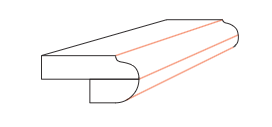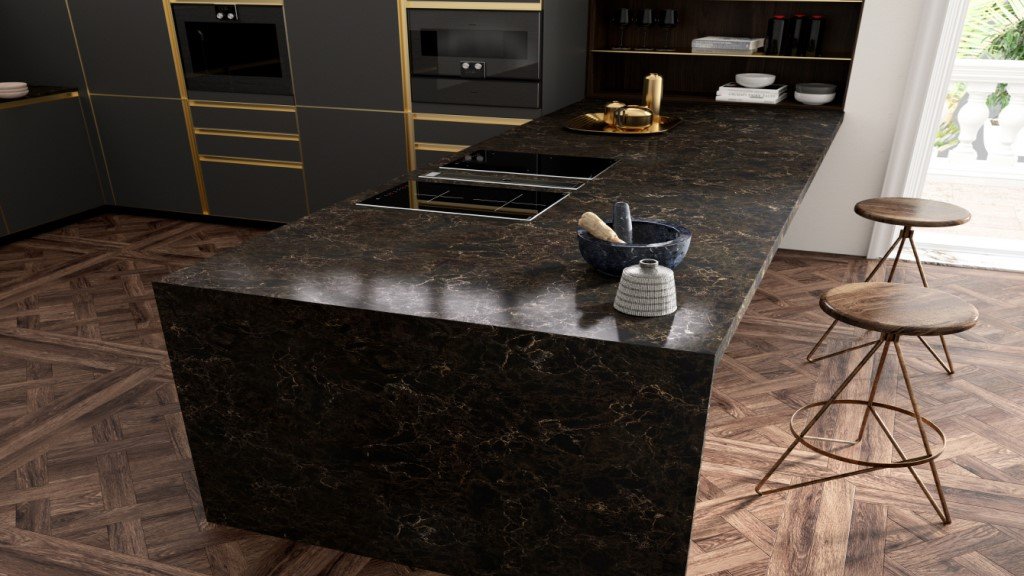Countertop Edge Profiles - Examples and Recommendations
One of the things that you will need to decide when choosing a new countertop for your kitchen or bathroom, is what type of edge you would like. Here are some of the more popular countertop edge profiles for quartz and other mineral material countertops. Click on each one to learn more.
If you would like help selecting the right countertop edge profile, contact us. We have the widest selection of natural stone countertops in Southern Ontario. Our highly experienced stone countertop specialists are here to answer all your questions. You can even visit our warehouse and select the perfect slab for your kitchen or bathroom.
Countertop Edge Profiles
1. Eased Edge
The rounded edge on an eased edge makes it safer - Image Source: Caesarstone
An eased edge is probably one of the most popular countertop edge profiles for quartz and granite countertops. The surface edges of an eased edge are rounded to eliminate the sharp 90 degree angle. An eased edge offers you many great benefits including:
Safe:
Eased edges are slightly rounded, which reduces the sharpness of the edges. This is a safer option, especially in your kitchen where you often move around quickly and if you have children in your home.
Easy to clean:
The eased edge profile is easier to clean compared to more intricate edge styles. Its simple design makes it less likely to trap dirt or crumbs, making it simpler to wipe down and maintain.
Durable:
Eased edges are less prone to chipping and damage compared to more ornate edge profiles. This can contribute to the longevity of your countertop, saving you potential repair or replacement costs in the long run.
Cost-Effective:
Eased edges are usually one of the most budget-friendly options when it comes to countertop edge profiles. Choosing a simpler edge can help you save on the overall cost of your quartz countertop installation.
2. Bevel Edge
Single Bevel - Image Source: Caesarstone
Double Bevel - Image Source: Caesarstone
A bevel edge is a type of edge profile where the top corner of the countertop is cut at a specific angle, typically 45 degrees, creating a slanted edge with a flat surface. This angled edge adds a subtle decorative detail to the countertop while maintaining a relatively simple and versatile design.
Bevel edges can be small or large, depending on the desired look. You can also have a double bevel edge that include a bevel both on the top and bottom edges of your countertop. Bevel edge countertops are a great option if you are looking for the following:
Design appeal:
Bevel edges can act as a subtle design accent, drawing the eye to the edge of the countertop and adding depth to the design. The angled cut reflects light differently, creating subtle shadows that enhance the visual appeal of your countertop.
Timeless design:
Bevel edges work well with various kitchen styles, from traditional to modern. Their timeless design ensures that they complement a wide range of cabinet designs and room aesthetics.
Easy to clean:
Bevel edges are relatively easy to clean because they don't have intricate details that can trap dirt and grime. The flat upper surface and angled cut make it convenient to wipe down and maintain.
3. Ogee Edge
And ogee edge will give your countertop an upscale look - Image Source: Caesarstone
An ogee countertop edge features an elegant, S-shaped curve with a concave dip followed by a convex rise, creating a sophisticated and ornate look. It is the perfect choice if you want your countertop to have the following features:
Distinctive appearance:
The ogee edge is highly decorative and adds a luxurious and upscale appearance to the countertop. The unique curves of the ogee edge set it apart from simpler edge profiles. It adds character and individuality to your countertop, making it stand out in your room.
Customization:
Ogee edges come in different sizes and variations, allowing for customization based on personal preferences and the overall design scheme of your space. You can choose from smaller, more subtle ogee profiles to larger, more ornate ones, tailoring the look to your liking.
Increased Resale Value:
The elegant and refined look of an ogee edge can contribute to the overall perceived value of a home. If you plan to sell your property in the future, such a high-quality edge profile might attract potential buyers and add to the resale value.
Smooth Transition:
Despite its ornate appearance, the ogee edge is designed to be smooth to the touch, eliminating sharp corners and edges. This feature enhances safety and makes the countertop more comfortable to use.
4. Bullnose Edge
Full Bullnose - Image Source: Caesarstone
Double Bullnose - Image Source: Caesarstone
Triple Bullnose - Image Source: Caesarstone
Bullnose is another type of countertop edge profiles that you can choose. It features a rounded edge on the top and bottom of the countertop, with the edges of the countertop curving inward. Here are some great reasons to choose a bullnose edge:
Classic design:
The bullnose design is popular because it is simple and elegant, and it can work well with a variety of kitchen styles including traditional, modern, and contemporary kitchens.
Safe:
The bullnose edge is also a safe option for households with children, as it does not have any sharp edges that could cause injury.
Great for granite:
The bullnose edge is a great option for many countertop materials, but it works especially well for granite.
Durable:
Because of its smooth edge, the bullnose design is very durable and won't damage easily.
5. Waterfall Edge
Waterfall countertop edge profiles will give you a stunning and dramatic look. *Above countertop by LX Hausys
A waterfall edge extends your countertop downward at its ends giving you a very dramatic “waterfall” effect. It uses more material to create this type of edge and the ends of your countertop will often touch the floor. This type of countertop edge profile is relatively easy to achieve with a quartz countertop, however it is less practical to have if you want a granite countertop.
This design choice has gained popularity due to its modern and luxurious aesthetic. Here are several reasons why someone might want a waterfall edge countertop seam:
Visual continuity:
Waterfall edges provide visual continuity, especially in open-concept spaces where the kitchen or bathroom is visible from other parts of the home. The uninterrupted flow of the countertop material creates a cohesive look and can enhance the overall design harmony.
Showcasing material:
Waterfall edges allow homeowners to showcase the beauty of the countertop material, whether it's natural stone like marble or granite, engineered quartz, or other high-end materials. The uninterrupted surface highlights the unique patterns, colours, and textures of the material.
Space definition:
In kitchen islands or breakfast bars, waterfall edges can define the space and add a sense of enclosure. This can be particularly useful in large, open kitchens where delineating different areas can enhance functionality and aesthetics.
Increased resale value:
Like other high-end countertop features, a well-executed waterfall edge can enhance the perceived value of a home. Potential buyers often find this design element appealing, which can make the property more attractive in the real estate market.
6. Flat / Mitered Edge
Flat countertop edge profiles will give you a simple, clean look - Image Source: Caesarstone
In a flat or mitered edge, two countertop sections are cut at a 45-degree angle where they meet at a corner. The edges are then glued together to create a seamless joint. The resulting edge appears to be a continuous, uninterrupted surface without a visible seam. A mitered edge is another one of the countertop edge profiles that offer you great advantages like:
Aesthetic appeal:
Flat edges give you a clean, modern look that many people find appealing. The absence of a visible seam gives the countertop a sleek and seamless appearance, enhancing the overall visual appeal of the kitchen or bathroom.
Versatility:
Flat edges can be applied to various countertop materials, including granite, marble, quartz, and laminate. This versatility allows homeowners to achieve a unified look across different countertop surfaces in the same space.
Hidden joints:
The mitered joint is less noticeable compared to other types of joints, such as a butt joint, where two countertop sections meet at a right angle. This hidden joint creates a more cohesive and elegant countertop surface.
Get Expert Countertop Advice from Natural Stone City.
Natural Stone City has the largest selection of Granite, Quartzite and Quartz in Southern Ontario, with over 100 colour options. You can choose from standard colours to super exotic options, shipped directly from Italy, Brazil and around the world. We carefully select each one, keeping the satisfaction of our customers in mind.
When you buy from Natural Stone City you’ll get:
Better value for your dollar
Any colour you want and more
Help from our knowledgeable staff who are experienced stone countertop specialists
Contact us today and we will help you choose the perfect countertop for your home.
What Our Customers Are Saying…
“We had a phenomenal experience working w Natural Stone City during a kitchen reno. When we first arrived we were quite overwhelmed and the amazing Gia came to our aid. She patiently showed us many options to consider and helped match to the samples we brought. We left w many counter samples and returned frequently as we made decisions, Gia and the team were always there to help. We ended up with a beautiful slab for our island that Gia arranged to have brought in from a supplier. From start to install, we could not have been happier. The customer care was next level. HIGHLY recommend and will go back for any future projects. Thank you Natural Stone City!”
—Gillian Siegwart









